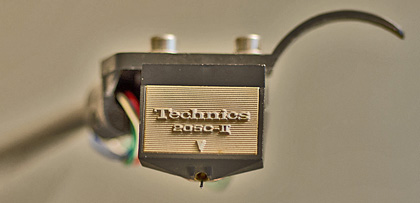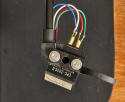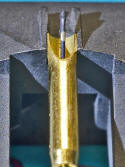-edible zone-
-- date: 7/14/2017
The Analog Dept. - Component Review:
Technics EPC 205C mkII moving magnet phono cartridge
Date: 7/14/2017
Reviewer: Steve Clarke
- Cartridge specs:
- Type: Moving Magnet
- Output Voltage: 3.5 mV
- Frequency Response: 10Hz - 40 kHz
- Tracking Force: 1.0 - 1.5g
- Mass: 6.5g
- Channel Separation: 25 db
- Load Impedance: 47k ohms
- Stylus: EPS-205ED
- Stylus Tip: elliptical 0.2 x 0.7mil
- Cantilever: titanium
- Dynamic Compliance: 10 x 10-6cm/Dyne
- FYI: 10 x 10-6 cm/dyne is the same as 10-um/mN.
*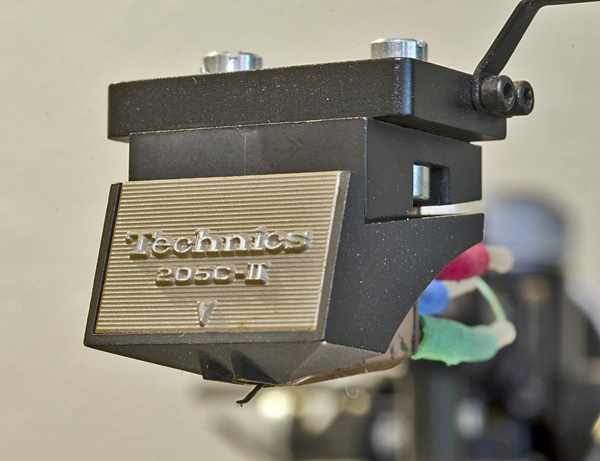
-- In the beginning……
I searched for one of these cartridges
because I had heard, from another vinyl nut, that this particular model
has been very well regarded, often overlooked, and back in the day was
moderately priced. Maybe I could find a used sample in good shape, and
for a reasonable price.
Motivation #2: Over the past few years I
have been looking for ‘exceptional’ examples of vintage moving magnet
cartridges that can be used on my Thorens TD124 turntable without having
any issues of the magnet within the cartridge pulling itself toward the
cast iron flywheel beneath the upper clutch-operated aluminum platter.
Moving coil phonograph cartridges have much larger magnets within them
than do moving magnet cartridges. Therefore the smaller magnet of the
moving magnet type will produce a lesser magnetic field and does not try
to pull itself down toward the iron flywheel of the Thorens.
However, this does happen when using some moving coil cartridges on the
TD124. Indeed there is a downward pull. Example; I have measured a Denon
DL-103R that exerted 1/2gram of pull toward the iron while using a
digital scale that puts the stylus at record height. This magnetic pull
can be compensated for in at at least one way I know of to accurately
set vertical tracking force on the original TD124. Yet, and no doubt,
this magnetic pull from beneath does modify the magnetic field
surrounding the moving coil cartridge. What effect this modified
magnetic field may or may not have on sound quality remains an
unanswered question. Then again, moving coil cartridges have been in use
on the TD124 (with iron flywheel) since its early days. Think Ortofon
SPU for example. And I have used a few different types of moving coil on
it to good effect. Yet, there is this nagging doubt.
Another
motivating factor for me is that I want to get familiar with some of the
more notable moving magnet cartridges from the past 30 to 40 years. Yes,
the elastomer donut that provides the suspension to the cantilever of
these old cartridges can and have deteriorated with years of exposure to
whatever atmospheres they were in. Other examples might be found to have
survived the years intact and still be serviceable. Two years ago I was
lucky when I found a new old stock (NOS) Sonus Blue. And then there was
that ADC ST XLM-II, still sealed in its factory package when I bought it
in 2013. Could I have similar good fortune in my hunt for a healthy EPC
205C MKII? Well, it helps when you buy from reputable sellers that know
their business. In this case I purchased my sample from Samurai
Electronics over eBay. They’ve been selling on eBay for several years
and maintain 100% positive feedback with over 3347 feedback. It just
seems likely that they are not going to risk any negative feedback. So I
bought a sample from their eBay store at $99.50 usd. Plus $10 to ship
from Japan to my location in Washington State. Delivery time was less
than a week. The cartridge arrived intact and appeared just as
described. Off to a good start.
Some have asked the question; is
it really true that moving coil cartridges sound superior to moving
magnet cartridges? I had already embarked on a path to explore this when
I reviewed the Sonus Blue and ADC ST-XLM II cartridges. There are a few
more vintage moving magnet cartridges I want to sample, but for now it
is this Technics model that I have in front of me.
When it comes
to matching tonearms and cartridges there are some math tools available
to help make reasonably accurate predictions prior to spending any
funds. And one of these will be discussed in this article down the page.
For now I can say that of the four tonearms in my possession I have
tried this cartridge in two of them. The first being a Graham 2.2. Then
I tried it in a very different and much lower mass Infinity Black Widow.
As part of my setup regimen I used the HFN-001 test record to measure
tonearm/cartridge system resonance in both of these arms. In the Graham
the arm/cartridge resonated at 8 Hz. In the Black Widow tonearm the
arm/cartridge resonated at 11 Hz. Both of these measures indicated a
match that should have worked well enough. Although, in the Graham, the
EPC 205C-II sounded somewhat restrained.
Listening. A summary of
observations:
Note: This was carried out over several days and
conclusions were drawn after listening to a long list of familiar albums
within my collection. In many ways these Lps are ‘the usual suspects’
that I am familiar with and will often use to evaluate various system
attributes.
BW/205C-II vs. Graham/205C-II:
- In the BW tonearm, the cartridge sound quality opens up.
- Transparency. A sense of openness and clarity that wasn’t there in the Graham..
- Tone, more lifelike than in the Graham arm.
- transients, the speed of attack seems more apparent and lively
- details, micro & macro. Become sharper.
- Bass weight is good. More weight than I heard from this arm when it carried the ADC ST XLM-II, or the Sonus Blue.
- Bass tone texture and tightness. It is well described. Not loose like at least one of the more expensive moving coil cartridge I’ve owned.
- Not as tight or texturally articulate in the bass frequencies as I have heard with a Shelter 501-II in the Graham tonearm.
- Mid-range: Coherent, of a whole with the upper and lower frequencies. Nothing added. Good.
- Upper frequencies: cleaner more articulate than before.
-- Don’t blame the Graham arm. Blame the guy that mounted the cartridge with too much compliance to it. Something in that setup just did not work well. Perhaps the suspension and tensioner wire within the stylus assembly were under too much strain to carry the higher mass when under the dynamic loading of the Graham which, by design, works well with medium and even low compliance phono cartridges. The Black Widow in this review makes a better match. While this may or may not be the optimal tonearm for this cartridge, it certainly sounds very good to my ear.
*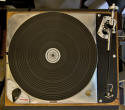 (click thumbnail for full size image)
(click thumbnail for full size image)
-- At this point I can, with good confidence, report that this EPC
205C-II cartridge does indeed make a good substitute for the conical
tipped Denon DL-103R. In fact, with its elliptical shaped stylus, it
reproduces greater detail. This is as expected. It also produces that
sense of drive, the visceral thrust that the Denon also does. Albeit,
though, in different tonearms. The Denon I have no plans of trying in
the Black Widow. I’m just noting that this Technics cartridge, I feel,
is a viable option and deserves consideration. But by all means put it
in a lower mass tonearm!
Let us keep in mind that this Technics
model cartridge was introduced in 1976 and (almost) any sample you find
will be used, old. There is some moderate financial risk involved in the
search. However the parts that wear out reside within the stylus
assembly and these plug in / pull out and can be renewed. With a brief
google web search I have found some replacement stylus assemblies coming
from Jico. At this point in time Jico produces three versions of
replacement stylus for the EPC 205C-II. One is reasonably priced that
features an elliptical diamond. It looks close to original except it
lacks the Technics logo on the front facia. The SAS version, with a
boron cantilever and Jico’s version of a micro-ridge shaped diamond* is
no longer produced. (rats!) The older SAS has been replaced by sapphire
and also ruby cantilevered versions called the Neo SAS/S and the Neo
SAS/R. You still get the Super Analog Stylus as before, but these two
Neo SAS versions cost quite a bit. The S version has a retail of $211.00
usd and the R is going for $412.00 usd. Just for comparison, the
original stylus assembly in my sample uses a titanium cantilever with a
(as previously noted) nude mounted elliptical diamond. I’d expect either
of the NEO SAS replacement assemblies to reproduce a superior sound due
to the stylus profile. Down the road I may try one. Likely I’d try the
SAS/S at half the price of the Ruby.
*(note that the SAS
identifies the diamond stylus as being their in-house shape known as
Super Analog Stylus)
Getting down to the nuts and bolts of it.
There is at least one thing this Technics EPC 205C-II and a Denon
DL-103R have in common. Their rated compliance value is achieved through
the same kind of test procedure where: dynamic compliance @100hz is
measured by determining the minimum VTF at which the onset of
mistracking occurs when playing a 50um amplitude 100Hz frequency
modulated groove. We can find reference to this explanation from noted
tonearm manufacturer H.H. Moerch at his website where he has published a
downloadable pdf we can refer to..
Here’s a link to that
document:
https://www.moerch.dk then go to:
homepage/instructions/cartridge armtube combination list)
In his
paper, Moerch offers a simple means to translate from the dynamic @100Hz
value to the more common 10Hz rating that many/most cartridges use.
Simply take the rated "dynamic" value and multiply by anywhere from 1.5
to 2. The Technics rated dynamic compliance of 10 * 10^6 cm/dyne,
multiply by 2 = 20 at the 10Hz method. And this is a value that can be
plugged into a formula offered within the same Moerch paper that can be
used to predict the tonearm/cartridge system resonance. Here it is:
*
-- Where:
- C = cartridge compliance in either ( __* um/mN or __ * 10^6 cm/dyne) (the same)
- Ma = tonearm effective mass in grams
- Mcar = cartridge weight in grams (add also the weight of fastener screws and nuts, etc)
- Fress = sustem resonance frequency in Hz
-- Using the above formula and plugging in the required values from the Black Widow spec list I came up with a predicted arm/cartridge resonance at 10.9hz. This proved to be close to reality as when using the HFN-001 test record, side 2 track 2 the measured resonance was 11Hz. The formula appears to work and so did H.H. Moerch’s simple method of conversion (times 2) noted above.
*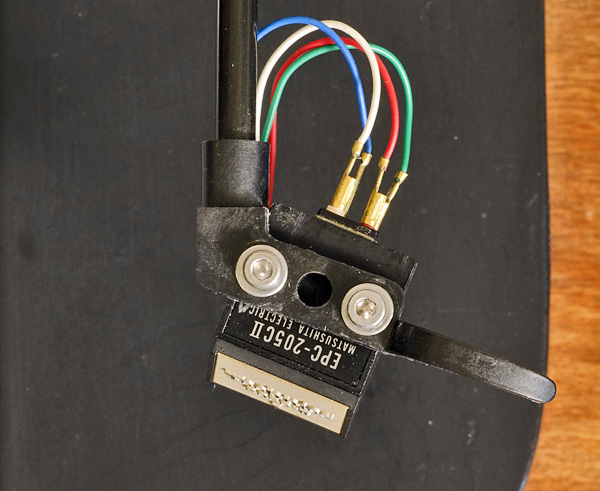
-- At this point I need to add an important note about fitting the
EPC 205C-II into the Black Widow headshell. As it was, the cartridge
body was approximately 1/16” too wide and would not clear the portion of
the headshell comprised of a cylindrical hub that slips over the carbon
fiber armtube and then is clamped by means of a small machine screw to
tighten down over said arm tube.
Other words; it would not fit
and could not be mounted to the Black Widow tonearm without doing the
following: I used a small fine-cut swiss pattern file to remove material
and make clearance both to the hub on the headshell as well as a similar
amount that was removed from the plastic mounting body adjacent the two
cartridge body M3 mounting holes. When done the cartridge mounted with
enough clearance to adjust zenith correctly without the cartridge body
making contact to the edge of the armtube. It is a close fit, but
everything cleared after the business with the fine-cut file. In this
way I was able to proceed.
- HFN 001 test record; Lateral tonearm/cartridge resonance measures at 8Hz in the Graham 2.2 tonearm. Link to movie of the test.
- HFN 001 test record: Side One, Bias tracks (torture tracks) 6 thru 9. Passes track 8 in the Graham 2.2 tonearm.
- HFN 001 test record: Lateral tonearm/cartridge resonance measures at 11hz in the Infinity Black Widow tonearm with a rated effective mass of just 3grams. Link to movie of the test
- HFN 001 test record: Side 1 bias tracks (torture tracks) 6 thru 9. Passes track 8 in the Infinity Black Widow tonearm.
-- Tonearm Alignment:
- Stevenson
- inner null: 60.325mm
- outer null: 117.43mm
- offset angle: 21°
- using a tad arc protractor
-- Note about the videos. File type is ".mov" . These will play back in either Window Media Player or Apple Quicktime. Using the Firefox browser is problematic. In my experience the sound does not play when using Firefox. However when using IE11 or Google Chrome the movie plays without any issue. You are welcome to download the video to your local hard drive.
Associated equipment:
- Speakers: NHT 2.9
- Amplifier/pre-amp: Classe’ CAP-151 integrated amplifier/pre-amplifier (150 wpc rms at 8 ohms)
- Phono stage: built-in solid state within the above noted Classe’ CAP-151 47ohm at input.
- Turntable: Thorens TD124 sn# 13943 with recent refurbish, mounted via:......fresh mushrooms from Audiosilente, plinth; repaired open box plywood, reinforced internally with mdf. Heavy rubber feet, on Neuance platform, over cork level adjusters, over heavy wood turntable base stand.
- Room treatments: none. I’ll be working on that.
-- Other notes: I just operate the formulas in this article. I don’t
devise them. Thanks to H.H. Moerch for providing this useful tool and
also for his explanation of the '@100Hz compliance' method. And this
reminds me, I need to try one of H.H. Moerch's tonearms...Word is that
they are very good.
